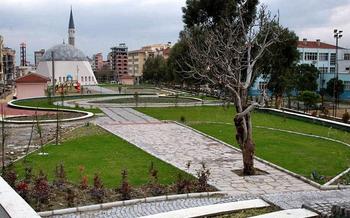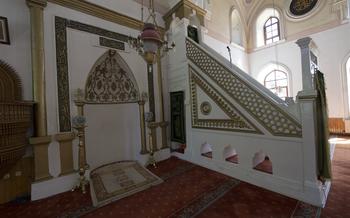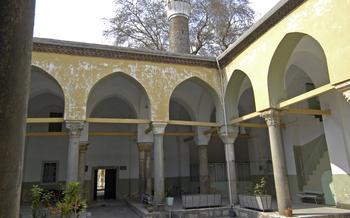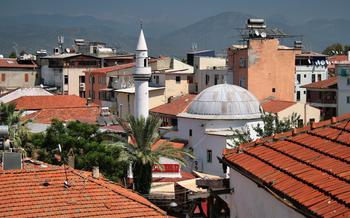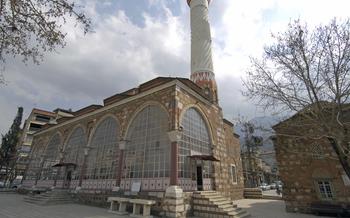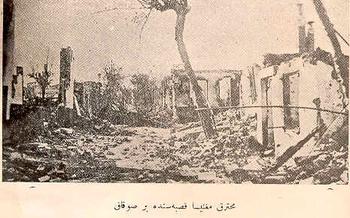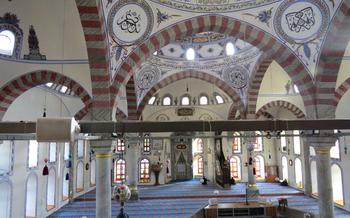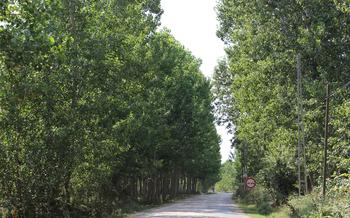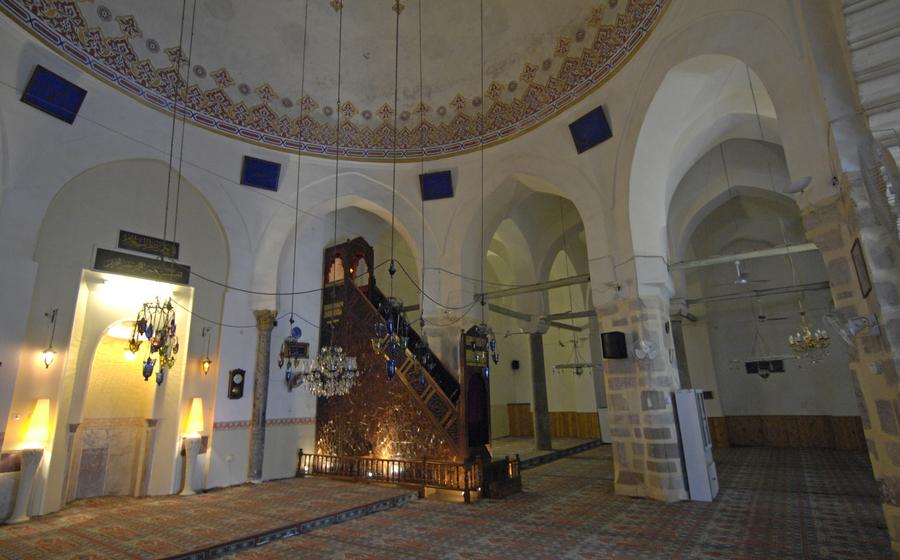
Akmescit Mosque
- Akmescit Mosque: A Majestic Symbol of Manisa's Cultural Heritage
- Step Back in Time: The History of Akmescit Mosque
- Immerse Yourself in Architectural Beauty
- Exploring the Mosque's Interior
- Unveiling the Cultural Significance
- A Place of Tranquility and Worship
- Join the Community for Prayer
- Discover the Neighborhood: Exploring the Enchanting Surroundings
- Plan Your Visit
- Capture the Beauty
- Beyond the Mosque: Exploring the City of Manisa
- Local Customs and Traditions:
- Finding Accommodation and Food
- Sustainable Travel Practices: Contributing to a Greener Manisa
- Insider Tip: The Secret Garden
Akmescit Mosque: A Majestic Symbol of Manisa's Cultural Heritage
The Akmescit Mosque stands as a testament to the rich cultural heritage of Manisa, Turkey. Built in the 14th century, the mosque holds a significant place in the city's history and architectural landscape. It was commissioned by the Aydınoğlu Dynasty, the local rulers of Manisa during the Beylik era, showcasing the city's historical importance as a center of trade and culture.
The mosque exhibits a blend of Seljuk and Ottoman architectural styles, showcasing pointed arches, intricate tilework, and elegant calligraphy, which have become synonymous with Turkish Islamic art. Its iconic silhouette, crowned by a series of graceful domes and minarets, dominates the city's skyline, making it a visual landmark that draws visitors from far and wide.
Beyond its architectural beauty, the Akmescit Mosque holds deep cultural significance for the people of Manisa. It serves as a symbol of unity and diversity, fostering a sense of community among the city's diverse population. Throughout its history, the mosque has been a gathering place for worship, celebrations, and social events, playing a vital role in shaping the cultural identity of the city.
Step Back in Time: The History of Akmescit Mosque
Standing as a testament to Manisa's rich past, the Akmescit Mosque boasts a captivating history that intertwines with the city's cultural and religious heritage. Built in the 14th century during the reign of the Anatolian Beyliks, the mosque's architectural style reflects the unique blend of Ottoman and Seljuk influences that shaped this era.
According to local lore, the mosque's construction was inspired by a dream of a pious man named Akmescit, who envisioned a magnificent house of worship on this very spot. His dream became a reality with the support of the local community, who united to bring the mosque to life. The construction of the mosque was a labor of love, with skilled artisans and craftsmen dedicating their talents to creating a sacred space that would stand the test of time.
Throughout its existence, the Akmescit Mosque has played a pivotal role in Manisa's history. It has witnessed the rise and fall of empires, served as a sanctuary for weary travelers, and hosted countless religious ceremonies and community events. Over the centuries, the mosque has undergone several renovations and restorations, each one contributing to its enduring legacy.
Today, the Akmescit Mosque stands as a symbol of Manisa's cultural heritage and a living testament to the city's rich past. Its historical significance and architectural beauty continue to captivate visitors from far and wide, who come to admire its grandeur and learn about its fascinating story.
Immerse Yourself in Architectural Beauty
The Akmescit Mosque stands as a testament to the exquisite craftsmanship and architectural prowess of the Ottoman era. Its exterior facade boasts intricate stone carvings, delicate tilework, and graceful arches that blend harmoniously to create a visually stunning masterpiece. The mosque's minaret, a symbol of Islamic architecture, rises majestically towards the sky, adding to the mosque's grandeur and prominence in the cityscape.
Stepping inside the mosque, visitors are greeted by an awe-inspiring spectacle of Islamic art and design. The vast prayer hall is adorned with a mesmerizing array of colorful tiles, each tile meticulously hand-painted with intricate patterns and verses from the Quran. The mihrab, the niche indicating the direction of Mecca, is a masterpiece in itself, adorned with intricate carvings and calligraphy that evoke a sense of reverence and spirituality.
The mosque's architectural significance lies in its unique blend of Ottoman and Seljuk design elements. The spacious layout, with its rows of elegant columns supporting the domed ceiling, is a testament to the Ottoman influence. At the same time, the intricate tilework and decorative motifs showcase the artistic legacy of the Seljuk era. This harmonious fusion of architectural styles creates a visually captivating space that reflects the rich cultural heritage of Turkey.
Exploring the Mosque's Interior
The interior of Akmescit Mosque is as captivating as its exterior. Step into the prayer hall, and you'll be awestruck by its spaciousness and grandeur. The layout is simple yet functional, with rows of plush carpets guiding worshippers towards the mihrab, the sacred niche indicating the qibla, the direction of prayer.
The mihrab itself is a masterpiece of craftsmanship, intricately carved with verses from the Quran and adorned with colorful ceramic tiles. The minbar, the elevated pulpit from which the imam delivers sermons, is equally impressive, showcasing fine woodwork and intricate geometric patterns.
The walls and ceiling of the prayer hall are adorned with exquisite tilework and calligraphy, creating a harmonious blend of art and spirituality. The tiles feature vibrant shades of blue, green, and turquoise, forming intricate geometric patterns and floral motifs. The calligraphy, in elegant Arabic script, displays verses from the Quran and the names of Allah and the Prophet Muhammad.
The natural lighting of the mosque adds to its serene atmosphere. Sunlight filters through the stained-glass windows, casting a warm glow on the interior. The acoustics of the mosque are also remarkable, allowing the imam's voice to resonate throughout the prayer hall, creating a sense of unity and devotion among the worshippers.
Unveiling the Cultural Significance
The Akmescit Mosque holds immense cultural significance as a vibrant hub for the Muslim community in Manisa. Beyond its religious function, the mosque serves as a gathering place, fostering a sense of unity and togetherness among the faithful. Various religious and social events are held within its walls, including congregational prayers, Qur'an recitals, and educational sessions. These events not only strengthen the bonds within the Muslim community but also promote interfaith dialogue and understanding.
The mosque's architectural grandeur and historic importance have earned it a prominent place in Manisa's cultural identity. It stands as a testament to the city's rich heritage and the harmonious coexistence of different cultures throughout history. The mosque's presence contributes to the city's diverse cultural landscape, making it a place where people of different faiths and backgrounds can come together and celebrate their shared humanity.
A Place of Tranquility and Worship
Stepping into the Akmescit Mosque, visitors are enveloped in an atmosphere of serenity and peacefulness. The mosque's serene ambiance invites worshippers to connect with their spirituality and find solace within its sacred walls. For Muslims, the mosque holds immense religious significance, serving as a place of worship and devotion. The daily prayers, known as "salat," are performed in congregation, fostering a sense of unity and community among the worshippers. During prayer times, the mosque comes alive with the melodic recitation of verses from the Quran, creating a spiritually uplifting environment. The mosque's serene atmosphere and sacredness promote religious tolerance and understanding, welcoming visitors of all faiths to experience the beauty of Islamic worship and appreciate the diversity of religious practices.
Join the Community for Prayer
The Akmescit Mosque is a vibrant place of worship, inviting both locals and visitors to join in the daily prayers. The mosque's serene atmosphere and welcoming community create an environment that fosters religious tolerance and understanding.
To fully immerse yourself in the local culture, participate in one of the daily prayers. The prayer schedule is displayed prominently at the entrance of the mosque, ensuring that you can plan your visit accordingly.
Before entering the mosque, remember to dress respectfully, covering your shoulders and knees. Men and women have separate prayer areas within the mosque, and visitors are welcome to join the congregation in their respective sections.
Once inside, follow the lead of the other worshippers, performing the ablutions and aligning yourself with the rows of worshippers. As the Imam begins the prayer, immerse yourself in the rhythmic movements and soothing recitations, feeling a sense of unity with the community.
After the prayer, take a moment to reflect on the experience and engage with the locals. They will likely be delighted to share their stories and answer any questions you may have about the mosque, their faith, and the local customs.
Discover the Neighborhood: Exploring the Enchanting Surroundings
Venture beyond the mosque's walls to discover the captivating neighborhood that envelops it. Stroll along the cobblestone streets, where history whispers from every corner. Explore the vibrant local markets, a symphony of colors and aromas, where you can haggle for unique souvenirs and sample delectable Turkish delights. Immerse yourself in the heart of Manisa's cultural tapestry at the Manisa Museum, showcasing the region's rich history and heritage. Marvel at the architectural grandeur of the Muradiye Mosque, another stunning testament to Ottoman artistry. Indulge in the tantalizing flavors of traditional Turkish cuisine at nearby restaurants, savoring the culinary delights that have made Turkish gastronomy world-renowned. Embrace the vibrant energy of this bustling neighborhood, where the past and present intertwine to create a truly unforgettable travel experience.
Plan Your Visit
To make the most of your visit to the Akmescit Mosque, consider the following tips:
-
Ideal time to visit: For a serene and peaceful experience, visit the mosque during non-prayer hours, typically early mornings or late afternoons. This allows you to explore the mosque's interior and admire its beauty without distractions.
-
Accessibility for visitors with disabilities: The mosque is generally accessible for visitors with disabilities, with ramps and elevators available for easy movement. However, it's advisable to inform the mosque authorities in advance to ensure any necessary assistance.
-
Guided tours and information resources: Guided tours are available for visitors who wish to learn more about the mosque's history, architecture, and cultural significance. Information brochures and pamphlets are also provided to enhance your understanding of the mosque.
-
Respecting the mosque's dress code and religious customs: As a sign of respect, visitors should dress modestly when visiting the mosque. Women are expected to cover their heads with a headscarf, while men should avoid shorts or sleeveless shirts. Additionally, it's essential to maintain silence and avoid disturbing worshippers during prayer times.
Capture the Beauty
The Akmescit Mosque's architectural splendor and serene atmosphere make it a picturesque subject for photography enthusiasts. While capturing the mosque's beauty, it's essential to be mindful of the sacred nature of the site. Photography is permitted within the mosque, but visitors should be respectful of worshippers and avoid using flash or causing disturbances.
To capture stunning images, consider visiting during the golden hours of sunrise or sunset when the mosque's exterior glows with warm hues. The intricate details of the mosque's facade, such as the carved stonework and tilework, are best captured with a wide-angle lens. For interior shots, a tripod can help stabilize your camera for sharp images of the intricate tilework, calligraphy, and the grand mihrab.
When sharing your photographs online, be sure to tag the mosque and use relevant hashtags to inspire others to visit this hidden gem. However, always obtain permission from individuals if they appear in your photos to respect their privacy. By capturing and sharing the beauty of the Akmescit Mosque, you can help promote its cultural significance and encourage others to appreciate this architectural masterpiece.
Beyond the Mosque: Exploring the City of Manisa
While the Akmescit Mosque stands as a captivating highlight, Manisa offers a wealth of additional attractions to enrich your visit. Immerse yourself in the natural wonders of Spil Mountain National Park, where breathtaking landscapes and hiking trails await. Delve into the city's rich past at the Manisa Archaeological Museum, housing a remarkable collection of artifacts from various civilizations.
Venture beyond the city center and embark on a day trip to the vibrant coastal metropolis of Izmir, renowned for its stunning beaches, bustling markets, and historical landmarks. Alternatively, journey to the ancient city of Ephesus, a UNESCO World Heritage Site, to marvel at its remarkably preserved ruins, including the iconic Temple of Artemis and the Library of Celsus.
Whether you seek adventure, history, or relaxation, Manisa and its surroundings offer a diverse tapestry of experiences to satisfy every traveler's curiosity. Explore the city's vibrant energy, discover hidden gems, and create lasting memories in this captivating region of Turkey.
Local Customs and Traditions:
When visiting the Akmescit Mosque and exploring Manisa, it is important to be mindful of local customs and traditions to ensure a respectful and enjoyable experience. Turkish culture places a high value on hospitality and welcoming visitors, but it is essential to be respectful of local customs and etiquette.
Here are a few tips to help you navigate the local culture:
- Greetings: When meeting someone for the first time, it is customary to shake hands and say "Merhaba" (Hello).
- Dress code: While there is no strict dress code in Turkey, it is advisable to dress modestly and conservatively, especially when visiting religious sites like the Akmescit Mosque. Avoid wearing shorts, tank tops, or revealing clothing.
- Respectful behavior: Be mindful of your behavior and avoid loud talking or disruptive actions within the mosque and other public spaces.
- Interacting with locals: Turks are generally friendly and welcoming, and they appreciate it when visitors make an effort to learn a few Turkish phrases. Simple greetings like "Merhaba" (Hello), "Teşekkür ederim" (Thank you), and "Görüşmek üzere" (Goodbye) can go a long way.
- Respect for religious customs: Remember that the Akmescit Mosque is an active place of worship, and it is essential to be respectful of the religious customs and practices observed there. Visitors should avoid entering the prayer hall during prayer times and should always ask permission before taking photographs.
By understanding and respecting local customs and traditions, you can ensure that your visit to the Akmescit Mosque and your time in Manisa are both enjoyable and enriching.
Finding Accommodation and Food
When planning your stay in Manisa, you'll find a range of accommodation options to suit different budgets and preferences. For a convenient and immersive experience, consider staying in a traditional Turkish guesthouse or boutique hotel near the Akmescit Mosque. These charming accommodations often offer a glimpse into local life and culture.
For a wider selection of hotels and amenities, the city center of Manisa provides a variety of options within easy reach of the mosque. Whether you prefer modern comforts or a more historical ambiance, you'll find suitable accommodations to make your stay comfortable and memorable.
Food lovers will delight in Manisa's culinary scene, which offers an array of traditional Turkish dishes and international cuisine. Indulge in mouthwatering kebabs, savory Turkish pizzas, and the famous Manisa mesir paste, a sweet delicacy made from 41 different spices. Explore the local markets and bazaars to discover fresh produce, spices, and traditional Turkish delights.
For a truly authentic experience, venture into the charming side streets and discover hidden gems serving up delicious local cuisine. Ask for recommendations from friendly locals or your hotel concierge to uncover the best culinary spots that Manisa has to offer.
Sustainable Travel Practices: Contributing to a Greener Manisa
As a responsible traveler, it's important to consider the environmental impact of your visit to the Akmescit Mosque and Manisa. Here are some tips for sustainable travel:
-
Minimize Plastic Waste: Avoid single-use plastics like water bottles and plastic bags. Instead, carry a reusable water bottle and opt for eco-friendly alternatives.
-
Support Local Businesses: Choose to stay in locally-owned hotels, eat at traditional restaurants, and shop at local markets. This supports the local economy and reduces the carbon footprint associated with imported goods.
-
Dispose of Waste Responsibly: Utilize recycling bins where available and properly dispose of waste to prevent pollution.
-
Conserve Water and Energy: Be mindful of your water usage and turn off lights and appliances when not in use.
-
Promote Sustainable Tourism: Share your experiences with friends and family, encouraging them to travel responsibly. Advocate for sustainable tourism practices to ensure the long-term preservation of Manisa's natural and cultural heritage.
By embracing these sustainable practices, you can contribute to a greener Manisa and inspire others to do the same. Every small effort makes a big difference in protecting the environment for future generations.
Insider Tip: The Secret Garden
Beyond the grand halls and intricate tilework of the Akmescit Mosque lies a hidden gem, a secret garden that offers a unique and serene experience for visitors. Nestled amidst the mosque complex, this tranquil oasis invites you to escape the hustle and bustle of the city and immerse yourself in the beauty of nature.
As you enter the garden, you are greeted by a lush green expanse adorned with colorful flowers, aromatic herbs, and towering trees. The gentle rustling of leaves and the sweet chirping of birds create a symphony of sounds that soothe the soul and transport you to a world of tranquility.
Take a moment to wander along the winding paths, admiring the vibrant blooms and the intricate patterns formed by the foliage. Find a secluded spot beneath a shady tree and allow yourself to be enveloped by the peace and serenity of the surroundings.
Remember, this hidden garden is a sacred space, a place of contemplation and reflection. Please be respectful of the sanctity of the mosque and maintain silence while exploring this beautiful oasis. Embrace the opportunity to connect with nature and find solace within the heart of the Akmescit Mosque complex.

